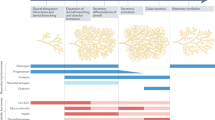Abstract
Milk production by the human breast is the end result of a long series of physiological changes. The breast alters in form, size and overall shape as the girl grows and develops into an adult woman. The key developmental stages include puberty, pregnancy and lactation. For breastfeeding to be fully possible, there must have been a series of physiological adaptations well before the neonate latches onto the breast for the first time. In this chapter, the way the breast develops its adult form (mammogenesis), the way the mammary gland develops the ability to produce milk (lactogenesis) and the way the milk is then delivered to the infant (lactation) are all discussed [1–4].
Access this chapter
Tax calculation will be finalised at checkout
Purchases are for personal use only
Similar content being viewed by others
References
Pillay J, Davis TJ. Physiology, lactation. [Updated 2022 Jul 18]. In: StatPearls [Internet]. Treasure Island (FL): StatPearls Publishing; 2022 Jan. https://www.ncbi.nlm.nih.gov/books/NBK499981/
Ventrella D, Forni M, Bacci ML, Annaert P. Non-clinical models to determine drug passage into human breast Milk. Curr Pharm Des. 2019;25(5):534–48.
Levine S, Muneyyirci-Delale O. Stress-induced hyperprolactinemia: pathophysiology and clinical approach. Obstet Gynecol Int. 2018;2018:9253083.
Hård AL, Nilsson AK, Lund AM, Hansen-Pupp I, Smith LEH, Hellström A. Review shows that donor milk does not promote the growth and development of preterm infants as well as maternal milk. Acta Paediatr. 2019;108(6):998–1007.
Bernard V, Young J, Binart N. Prolactin—a pleiotropic factor in health and disease. Nat Rev Endocrinol. 2019;15(6):356–65.
Weaver G, Bertino E, Gebauer C, Grovslien A, Mileusnic-Milenovic R, Arslanoglu S, Barnett D, Boquien CY, Buffin R, Gaya A, Moro GE, Wesolowska A, Picaud JC. Recommendations for the establishment and operation of human milk banks in Europe: a consensus statement from the European Milk Bank Association (EMBA). Front Pediatr. 2019;7:53.
Hahn-Holbrook J, Saxbe D, Bixby C, Steele C, Glynn L. Human milk as “chrononutrition”: implications for child health and development. Pediatr Res. 2019;85(7):936–42.
Wallace TC, Blusztajn JK, Caudill MA, Klatt KC, Natker E, Zeisel SH, Zelman KM. Choline: the underconsumed and underappreciated essential nutrient. Nutr Today. 2018;53(6):240–53.
Sampieri CL, Montero H. Breastfeeding in the time of Zika: a systematic literature review. PeerJ. 2019;7:e6452.
Tauber KA. Human milk and lactation. In: Nimavat DJ, editor. Medscape. Updated: Jun 29, 2021. https://emedicine.medscape.com/article/1835675-overview#a7. Accessed 2 Dec 2022.
Hassiotou F, Geddes D. Anatomy of the human mammary gland: current status of knowledge. Clin Anat. 2013;26(1):29–48.
Haslam SZ, Shyamala G. Effect of oestradiol on progesterone receptors in normal mammary glands and its relationship with lactation. Biochem J. 1979;182(1):127–31.
Haslam SZ, Shyamala G. Progesterone receptors in normal mammary glands of mice: characterization and relationship to development. Endocrinology. 1979;105(3):786–95.
Auerbach KG, Riordan J. Breastfeeding and human lactation. Boston: Jones and Bartlett Publishers; 1993.
Bernard V, Young J, Chanson P, Binart N. New insights in prolactin: pathological implications. Nat Rev Endocrinol. 2015;11(5):265–75.
Neville MC. Physiology of lactation. Clin Perinatol. 1999;26(2):251–79. v
Black RF, Jarman L, Simpson JB. The process of breastfeeding. Lactation specialist self-study series. Sudbury, MA: Jones and Bartlett Publishers; 1998.
Author information
Authors and Affiliations
Editor information
Editors and Affiliations
Rights and permissions
Copyright information
© 2023 The Author(s), under exclusive license to Springer Nature Switzerland AG
About this chapter
Cite this chapter
Kurt, N.C., Di Renzo, G.C. (2023). Physiological Aspects of Lactation. In: Şahin, Ö.N., Briana, D.D., Di Renzo, G.C. (eds) Breastfeeding and Metabolic Programming. Springer, Cham. https://doi.org/10.1007/978-3-031-33278-4_5
Download citation
DOI: https://doi.org/10.1007/978-3-031-33278-4_5
Published:
Publisher Name: Springer, Cham
Print ISBN: 978-3-031-33277-7
Online ISBN: 978-3-031-33278-4
eBook Packages: MedicineMedicine (R0)




